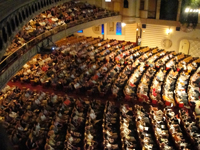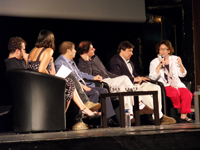 |
 |
|||||||||||||
|
|||||||||||||
|
|||||||||||||
How do you gather 2,000 Parisians and tourists in the middle of summer to talk about particle physics during a whole night? Probably following this recipe: find a magic venue, invite fascinating speakers and well-known artists, explore the frontier between science and cinema and advertise, advertise, advertise. Well, at least this is how the "Nuit des particules" – Particle Night – organised on 27 July at the Grand Rex theatre in Paris by the International Conference on High Energy Physics (ICHEP2010) this year happened to be a success. With the special science-and-cinema evening entitled the "Nuit des particules", ICHEP organisers wanted to provide an opportunity to discuss science in cinema and the mysteries of the infinitely small and the infinitely large with the public. The night started with a general public lecture given by Michel Davier, professor at Paris-Sud University and member of the French Academy of Sciences, who explained the links between the cosmos and the particles. The questions from the public were diverse, sometime very general, sometimes very precise, but interestingly enough 99 percent were about science. And some people were inspired: “If you could look at the vacuum, what would you see?” “Why are there three families of leptons?” “How does the standard model of particles treat the graviton?”, to quote a few questions Davier received. The debate which followed featured the actress Irène Jacob, winner of the Best Actress Award in 1991 at the Cannes Film Festival. Irène Jacob is the daughter of CERN theorist Maurice Jacob and she explained how she spent her childhood in Geneva, surrounded by particle physicists. With the memories of her late father, she wrote, together with the Italian theatre actor-director Pippo Delbono a short movie entitled "Alice" which premiered at the Grand Rex. On stage were also Pierre Antilogus, CNRS researcher specialised in supernovae, Gautier Hamel de Monchenault, CEA physicist and member of the CMS Large Hadron Collider experiment, and Marie-Hélène Schune, CNRS physicist and member of the LHCb Large Hadron Collier experiment. All of them discussed about the facts and fictions in cinema, with excerpts from Ron Howard's Angels and Demons and Danny Boyle's Sunshine. Both movies had CERN scientific advisors. One of the conclusions of the debate was that, although there were many wrong or exaggerated statements in the films, there was always a grain of truth in them, even if it was only the terms and expressions used by the actors to play scientists or in some facts that are likely to become a reality in the future. The night ended with entertainment as science-fiction movie Sunshine was shown on the big screen of the Grand Rex. The Night of Particles was organised with the support of CNRS Cinemascience festival, CEA, la Mairie de Paris, Science sur Seine and "Le Monde" newspaper. During the conference, other free scientific events and activities were offered to the general public as part of the "Paris plage" summer operation. Such large interest of the public in particle physics surprised the organisers. This means we should all provide more occasions to mix entertainment and outreach activities. The general public is obviously expecting us to tell them more science stories. -- Perrine Royole-Degieux
Links
– Event website (in French)
– Michel Davier's presentation (in French) – Irène Jacob visits CERN (from the CERN Bulletin) |
|||||||||||||
| © International Linear Collider |


